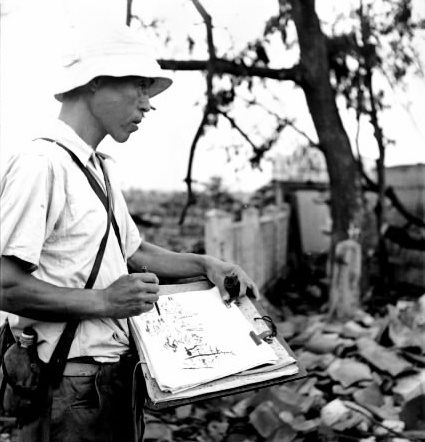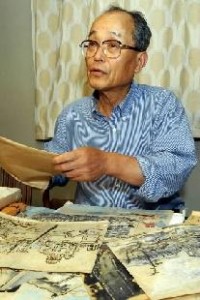Images of the Atomic Bombing, 1945~2003, Part 1
Jun. 26, 2010
Sketches of the ruins
by Masami Nishimoto, Senior Staff Writer
In the summer of 2003, the Hiroshima Peace and Culture Foundation obtained 226 photographs from the U.S. National Archives which show the devastation caused by the atomic bombing. The photos the American forces took in their investigation of the effects of the bombing are witnesses that convey the tragedy of that time. This series [originally published in July and August 2003] traces the reality of the atomic bombing through some of these images.
Compelled to picture the tragedy for future generations
The man absorbed with his paintbrush in the ruins wrought by a single atomic bomb is Keizo Takamasu, then 45. He was a teacher at the Hiroshima Prefectural School for the Deaf. I searched for his surviving relatives and located his oldest son, who was with him at the time this photo was taken by a member of the U.S. forces. The son's diary from that time recorded the date: September 9, 1945. Mr. Takamasu's sketch of the Hatchobori district, which is seen in the photo, as well as 17 other drawings remain. These are "A-bomb pictures" produced very early on.
"Yes, I remember. We spotted U.S. soldiers and my father told me to hide, so I ducked out of sight."
Fumio Takamasu, 67, Keizo Takamasu's son, recalled the scene as he studied the photo of his father sketching amid the devastation of Hiroshima from his home in Asumigaoka, Chiba Prefecture. At the time, he was a fourth grader in elementary school.
His father was a teacher at the Hiroshima Prefectural School for the Deaf, located in the city center. But in order to avoid air raids, the school was relocated to Yoshida-cho, 45 kilometers north of the city, in April 1945. Fumio and his older sister moved there with their father. Their mother had died of illness the previous year.
"The mushroom cloud was visible from Yoshida-cho. My father sketched it." Fumio took out a box with the words "A-bomb Sketches" written on it. He brought out the early "A-bomb pictures" which had been forgotten in the wake of the devastating attack.
The monstrous A-bomb cloud rising beyond the mountains; the Hatchobori district in ruins; the A-bomb Dome and Motoyasu Bridge, apparently on the verge of collapse--in all, 18 sketches. The pictures were drawn in ink and colored with pastel. To some have been added the prayer "Rest in peace." As paper was short in those days, the sketches were made on the back of old scrap paper used at the School for the Deaf.
Why did Mr. Takamasu venture into the city with his young son in the midst of the incredible chaos caused by the atomic bombing and Japan's defeat? The reason was closely related to his past.
Born in Tokyo, Keizo Takamasu lost his hearing early in his childhood. While attending a school for the deaf, he studied Japanese painting. On September 1, 1923, he experienced the Great Kanto Earthquake. He created a picture scroll of Tokyo in flames, a conflagration that resulted in about 140,000 deaths. In the aftermath, his deaf friend was shot to death by a military policeman who took him for a spy.
"I'm sure he felt compelled to make these drawings for future generations," said Fumio. "He took me with him in case there was any trouble." The son was expected to serve as the father's interpreter.
When were these A-bomb sketches made? Fumio Takamasu told me his diary from those days still exists. It has been stored with his sister, Utako Tamaru, 70, who lives in Naka Ward, Hiroshima.
"This photo was taken on September 9," he said. The photographer is thought to be a member of the Manhattan District Survey Team. The team had arrived in Hiroshima the day before to investigate the existence of residual radiation.
When Keizo Takamasu and his two children entered the city on August 14 to check on the condition of their house and the school, they were exposed to the radiation. They never obtained the Atomic Bomb Survivor's Certificate, though, "because we couldn't find witnesses able to verify that we were there in the city." Utako, following the recommendation of her father who died in 1985 at the age of 84, was also a teacher at the Hiroshima School for the Deaf.
Mr. Takamasu first showed his sketches to the public in 1954. After his father's death, Fumio inherited the drawings and took up his father's wish to maintain the pictures for posterity.
"My father put his heart into these pictures," said Fumio, adding that his father's pen name was Keiso. "I hope they'll be viewed by many people in Hiroshima, if they're carefully preserved."
The act of drawing pictures of the A-bomb devastation, which Hiroshima citizens have continued up to the present, all started in the immediate aftermath of the blast.
(Originally published on July 29, 2003)









